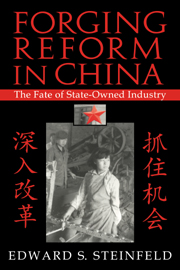Book contents
- Frontmatter
- Contents
- List of Tables and Figures
- Preface
- 1 Introduction: China's Ailing State Enterprises
- Part I Conceptual Approaches to Postsocialist Enterprise Reform
- Part II Enterprise Case Studies: The Commanding Heights in Transition
- 4 The Living Museum of Iron and Steel Technology
- 5 King of the Red Chips: Ma'anshan Steel and the Debacle of the “Public” SOE in China
- 6 Shougang: The Rise and Fall of an Industrial Giant
- Part III Reassessing Chinese Patterns of Economic Development
- Notes
- Bibliography
- Index
4 - The Living Museum of Iron and Steel Technology
Published online by Cambridge University Press: 12 January 2010
- Frontmatter
- Contents
- List of Tables and Figures
- Preface
- 1 Introduction: China's Ailing State Enterprises
- Part I Conceptual Approaches to Postsocialist Enterprise Reform
- Part II Enterprise Case Studies: The Commanding Heights in Transition
- 4 The Living Museum of Iron and Steel Technology
- 5 King of the Red Chips: Ma'anshan Steel and the Debacle of the “Public” SOE in China
- 6 Shougang: The Rise and Fall of an Industrial Giant
- Part III Reassessing Chinese Patterns of Economic Development
- Notes
- Bibliography
- Index
Summary
THE best way to understand the “nested problems” dynamic and related dilemmas of SOE restructuring is to delve into the operations of the individual firm. This chapter will do that by focusing upon the Anshan Iron and Steel Company, a 220,000-employee integrated steel operation based in Liaoning Province, the heart of China's Manchurian “rust belt.”
Anshan Iron and Steel, known informally as “Angang,” once stood at the commanding heights of China's planned economy. The whole point of command economics was to foster firms like Angang. Indeed, command planning was so appealing precisely because it could direct resources to heavy industrial producers in ways that markets never could. Without the plan, such firms could never have survived in China. In the heyday of the command era, Angang received virtually all of its investment capital and inputs from the plan, and it produced virtually all of its output for the plan. The system set clear managerial incentives: output was to be maximized at given levels of state-allocated inputs. The clear goal was to match annual production targets.
Needless to say, staggering changes have swept across Angang since the days of command planning. Over the past fifteen years, the entire system of state allocation has essentially been dismantled, and the industrial behemoths that once served that system now struggle to negotiate a transition to the market. For the most part, goods now flow freely between producers and consumers. Prices, even for many basic industrial inputs, have been liberalized.
- Type
- Chapter
- Information
- Forging Reform in ChinaThe Fate of State-Owned Industry, pp. 81 - 123Publisher: Cambridge University PressPrint publication year: 1998



